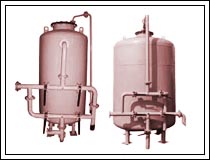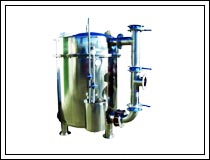Sand Filtration
Sand filtration is a very basic and cost effective method of treating contaminated water. Sand filtration utilizes the filtering properties of sand and produces clean water that is perfectly safe for consumption. Moreover, as this process requires little or no mechanical power, chemicals or replaceable parts or even minimal  operator training, but only demands for some amount of periodic maintenance, it is the best option of water treatment for people living in the economically challenged and isolated areas. operator training, but only demands for some amount of periodic maintenance, it is the best option of water treatment for people living in the economically challenged and isolated areas.
The Mechanism
In this process, water is let to pass through a bed of sand that makes the larger suspended particles settle in the top layers of sand. Smaller particles of organic sediment left in the sand filter are eaten by microscopic organisms including bacteria and protozoans which 'stick' in the layers of slime that form around the sand particles. The clean water which passes through the filter is safe to drink.
There are three main types of sand filters :
- Rapid Sand Filters
- Upflow Sand Filters
- Slow Sand Filters.
Rapid Sand Filters
These type of sand filters are generally used in municipal drinking water facilities as part of a multiple-stage treatment system. They employ relatively coarse sand and other granular media to treat the water of impurities that have been trapped in a floc through the use of flocculation chemicals. As the water is made to flow through the sand matrix, the flocculated material is trapped and the water that comes out is pure and ready to drink.
Upflow Sand Filters
The upflow sand filter functions on the continuous cleaning principle and is very effective in yielding stable and good-quality filtered water under constant pressure loss. It consists of a water influent pipe and a raw water distributor through which the water ascends to the raw filtration bed. The suspended solids are removed and the filtered water collects at the filtrate through the filtrate discharge.

Slow Sand Filters
These sand filters are non-pressurized systems and use biological processes to treat water. Although in most slow sand filters cleaning is done by using a mechanical scrapper which is usually driven into the filter bed once it has been dried out, there are some filters that function on the basis of a method called wet harrowing, where the sand is scraped while still under water, and the water used for cleaning is drained to waste.
Applications of Sand Filtration
- Preparation of cooling water
- Treatment of wastewater
- Production of drinking water
- Filtration in swimming pools
- Pre filtration for membrane systems
- Filtration of grey or surface water
- Removal of iron.
 |
Rapid Sand Filters
Sand filtration is a very basic and cost effective method of treating contaminated water. Sand filtration utilizes the filtering properties of sand and produces clean water that is perfectly safe for consumption.
|
|
 |
Slow Sand Filters
A slow sand filter is the most commonly used type of sand filter. Sand filtration utilizes the filtering properties of sand and produces clean water that is perfectly safe for consumption.
|
|
|
|